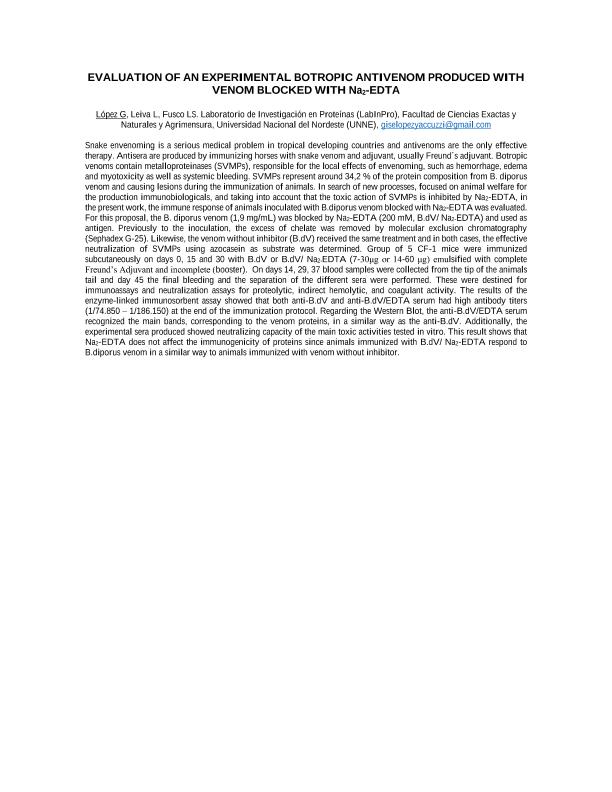Evento
Evaluation of an experimental botropic antivenom produced with venom blocked with Na2-EDTA
Tipo del evento:
Reunión
Nombre del evento:
XXIII Annual Meeting of the Argentinean Biology Society
Fecha del evento:
30/11/2022
Institución Organizadora:
Sociedad Argentina de Biología;
Título de la revista:
Biocell
Editorial:
Tech Science Press
ISSN:
0327-9545
e-ISSN:
1667-5746
Idioma:
Inglés
Clasificación temática:
Resumen
Snake envenoming is a serious medical problem in tropical developing countries and antivenoms are the only effective therapy. Antisera are produced by immunizing horses with snake venom and adjuvant, usually Freund´s adjuvant. Botropic venoms contain metalloproteinases (SVMPs), responsible for the local effects of envenoming, such as hemorrhage, edema and myotoxicity as well as systemic bleeding. SVMPs represent around 34,2 % of the protein composition from B. diporus venom and causing lesions during the immunization of animals. In search of new processes, focused on animal welfare for the production immunobiologicals, and taking into account that the toxic action of SVMPs is inhibited by Na2-EDTA, in the present work, the immune response of animals inoculated with B.diporus venom blocked with Na2-EDTA was evaluated. For this proposal, the B. diporus venom (1,9 mg/mL) was blocked by Na2-EDTA (200 mM, B.dV/ Na2-EDTA) and used as antigen. Previously to the inoculation, the excess of chelate was removed by molecular exclusion chromatography (Sephadex G-25). Likewise, the venom without inhibitor (B.dV) received the same treatment and in both cases, the effective neutralization of SVMPs using azocasein as substrate was determined. Group of 5 CF-1 mice were immunized subcutaneously on days 0, 15 and 30 with B.dV or B.dV/ Na2-EDTA (7-30μg or 14-60 μg) emulsified with complete Freund?s Adjuvant and incomplete (booster). On days 14, 29, 37 blood samples were collected from the tip of the animals tail and day 45 the final bleeding and the separation of the different sera were performed. These were destined for immunoassays and neutralization assays for proteolytic, indirect hemolytic, and coagulant activity. The results of the enzyme-linked immunosorbent assay showed that both anti-B.dV and anti-B.dV/EDTA serum had high antibody titers (1/74.850 ? 1/186.150) at the end of the immunization protocol. Regarding the Western Blot, the anti-B.dV/EDTA serum recognized the main bands, corresponding to the venom proteins, in a similar way as the anti-B.dV. Additionally, the experimental sera produced showed neutralizing capacity of the main toxic activities tested in vitro. This result shows that Na2-EDTA does not affect the immunogenicity of proteins since animals immunized with B.dV/ Na2-EDTA respond to B.diporus venom in a similar way to animals immunized with venom without inhibitor.
Palabras clave:
Na2EDTA
,
ANTIVENOM
,
ANTIBODY
Archivos asociados
Licencia
Identificadores
Colecciones
Eventos(IQUIBA-NEA)
Eventos de INSTITUTO DE QUIMICA BASICA Y APLICADA DEL NORDESTE ARGENTINO
Eventos de INSTITUTO DE QUIMICA BASICA Y APLICADA DEL NORDESTE ARGENTINO
Citación
Evaluation of an experimental botropic antivenom produced with venom blocked with Na2-EDTA; XXIII Annual Meeting of the Argentinean Biology Society; Buenos Aires; Argentina; 2022; 1-1
Compartir




